Gap in Bill No3 of 2017
VerifiedAdded on 2023/06/08
|6
|1429
|160
AI Summary
This paper argues about the gap in the Bill for an Act to amend the Workmen’s Compensation Act, 1964. It focuses on the Bill No3 of 2017, that is, the Workmen’s Compensation (Amendment) Bill, 2017 and analyses the gap in the Bill regarding the lack of attention towards the Mining Sector an...
Read More
Contribute Materials
Your contribution can guide someone’s learning journey. Share your
documents today.
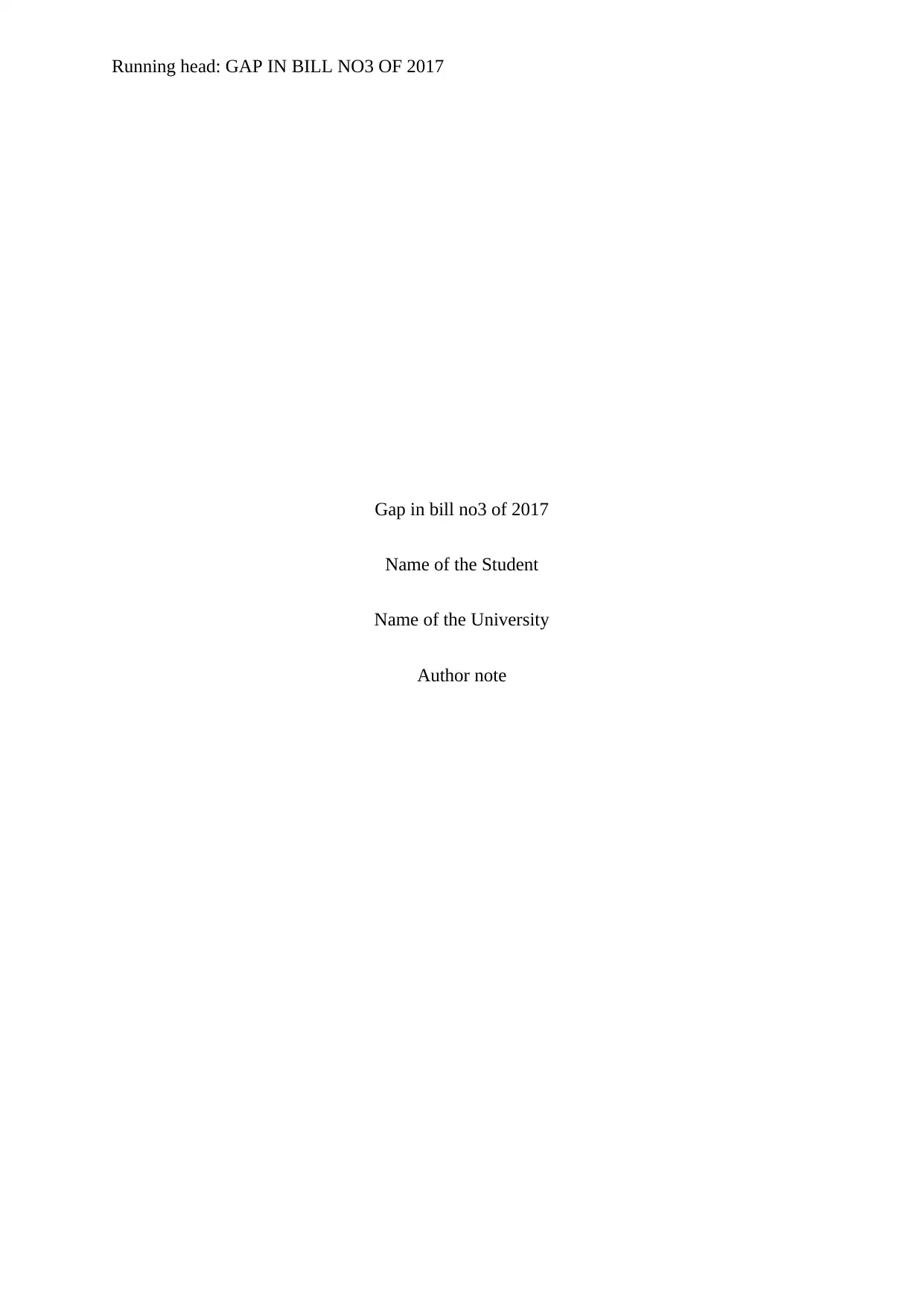
Running head: GAP IN BILL NO3 OF 2017
Gap in bill no3 of 2017
Name of the Student
Name of the University
Author note
Gap in bill no3 of 2017
Name of the Student
Name of the University
Author note
Secure Best Marks with AI Grader
Need help grading? Try our AI Grader for instant feedback on your assignments.
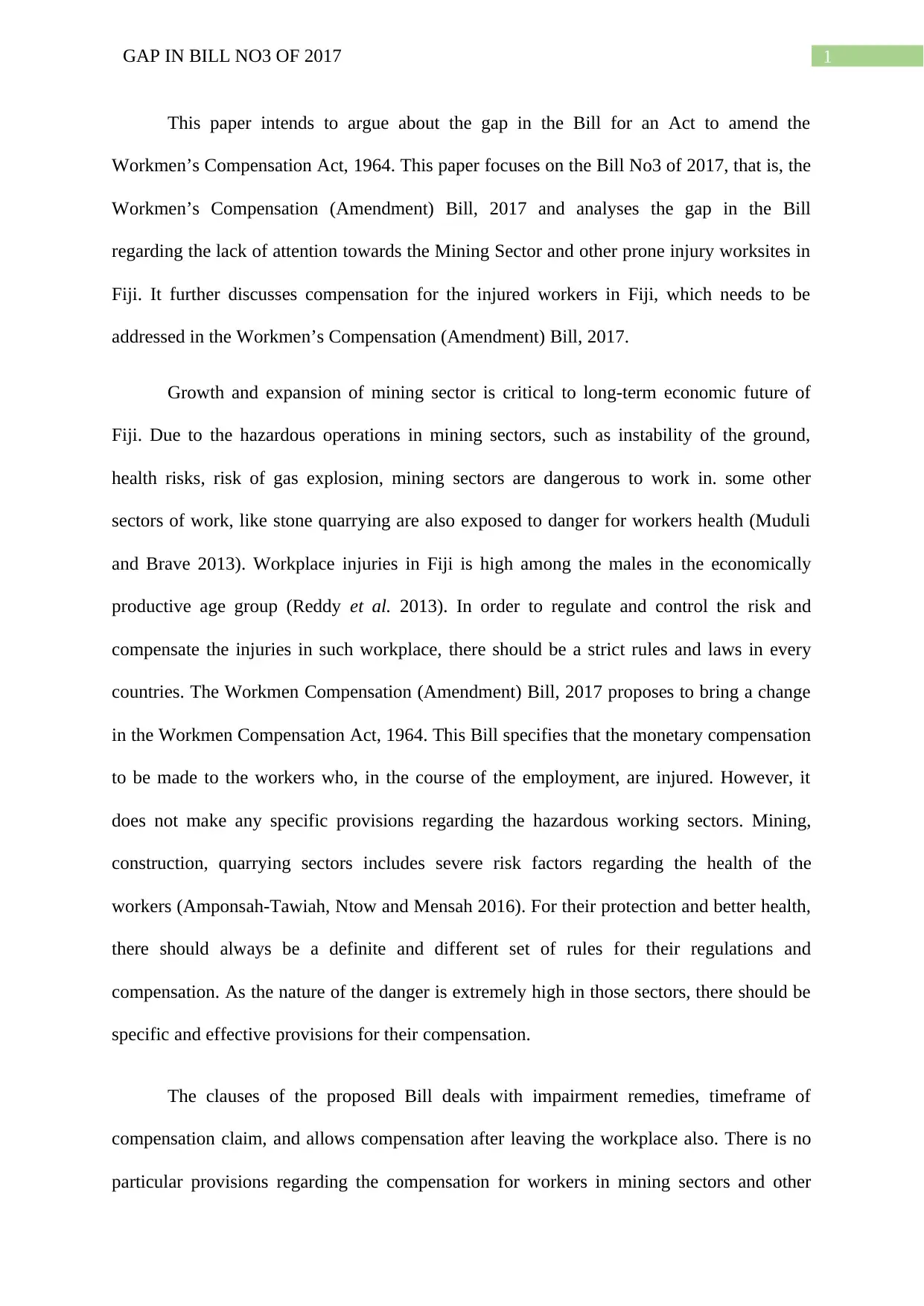
1GAP IN BILL NO3 OF 2017
This paper intends to argue about the gap in the Bill for an Act to amend the
Workmen’s Compensation Act, 1964. This paper focuses on the Bill No3 of 2017, that is, the
Workmen’s Compensation (Amendment) Bill, 2017 and analyses the gap in the Bill
regarding the lack of attention towards the Mining Sector and other prone injury worksites in
Fiji. It further discusses compensation for the injured workers in Fiji, which needs to be
addressed in the Workmen’s Compensation (Amendment) Bill, 2017.
Growth and expansion of mining sector is critical to long-term economic future of
Fiji. Due to the hazardous operations in mining sectors, such as instability of the ground,
health risks, risk of gas explosion, mining sectors are dangerous to work in. some other
sectors of work, like stone quarrying are also exposed to danger for workers health (Muduli
and Brave 2013). Workplace injuries in Fiji is high among the males in the economically
productive age group (Reddy et al. 2013). In order to regulate and control the risk and
compensate the injuries in such workplace, there should be a strict rules and laws in every
countries. The Workmen Compensation (Amendment) Bill, 2017 proposes to bring a change
in the Workmen Compensation Act, 1964. This Bill specifies that the monetary compensation
to be made to the workers who, in the course of the employment, are injured. However, it
does not make any specific provisions regarding the hazardous working sectors. Mining,
construction, quarrying sectors includes severe risk factors regarding the health of the
workers (Amponsah-Tawiah, Ntow and Mensah 2016). For their protection and better health,
there should always be a definite and different set of rules for their regulations and
compensation. As the nature of the danger is extremely high in those sectors, there should be
specific and effective provisions for their compensation.
The clauses of the proposed Bill deals with impairment remedies, timeframe of
compensation claim, and allows compensation after leaving the workplace also. There is no
particular provisions regarding the compensation for workers in mining sectors and other
This paper intends to argue about the gap in the Bill for an Act to amend the
Workmen’s Compensation Act, 1964. This paper focuses on the Bill No3 of 2017, that is, the
Workmen’s Compensation (Amendment) Bill, 2017 and analyses the gap in the Bill
regarding the lack of attention towards the Mining Sector and other prone injury worksites in
Fiji. It further discusses compensation for the injured workers in Fiji, which needs to be
addressed in the Workmen’s Compensation (Amendment) Bill, 2017.
Growth and expansion of mining sector is critical to long-term economic future of
Fiji. Due to the hazardous operations in mining sectors, such as instability of the ground,
health risks, risk of gas explosion, mining sectors are dangerous to work in. some other
sectors of work, like stone quarrying are also exposed to danger for workers health (Muduli
and Brave 2013). Workplace injuries in Fiji is high among the males in the economically
productive age group (Reddy et al. 2013). In order to regulate and control the risk and
compensate the injuries in such workplace, there should be a strict rules and laws in every
countries. The Workmen Compensation (Amendment) Bill, 2017 proposes to bring a change
in the Workmen Compensation Act, 1964. This Bill specifies that the monetary compensation
to be made to the workers who, in the course of the employment, are injured. However, it
does not make any specific provisions regarding the hazardous working sectors. Mining,
construction, quarrying sectors includes severe risk factors regarding the health of the
workers (Amponsah-Tawiah, Ntow and Mensah 2016). For their protection and better health,
there should always be a definite and different set of rules for their regulations and
compensation. As the nature of the danger is extremely high in those sectors, there should be
specific and effective provisions for their compensation.
The clauses of the proposed Bill deals with impairment remedies, timeframe of
compensation claim, and allows compensation after leaving the workplace also. There is no
particular provisions regarding the compensation for workers in mining sectors and other
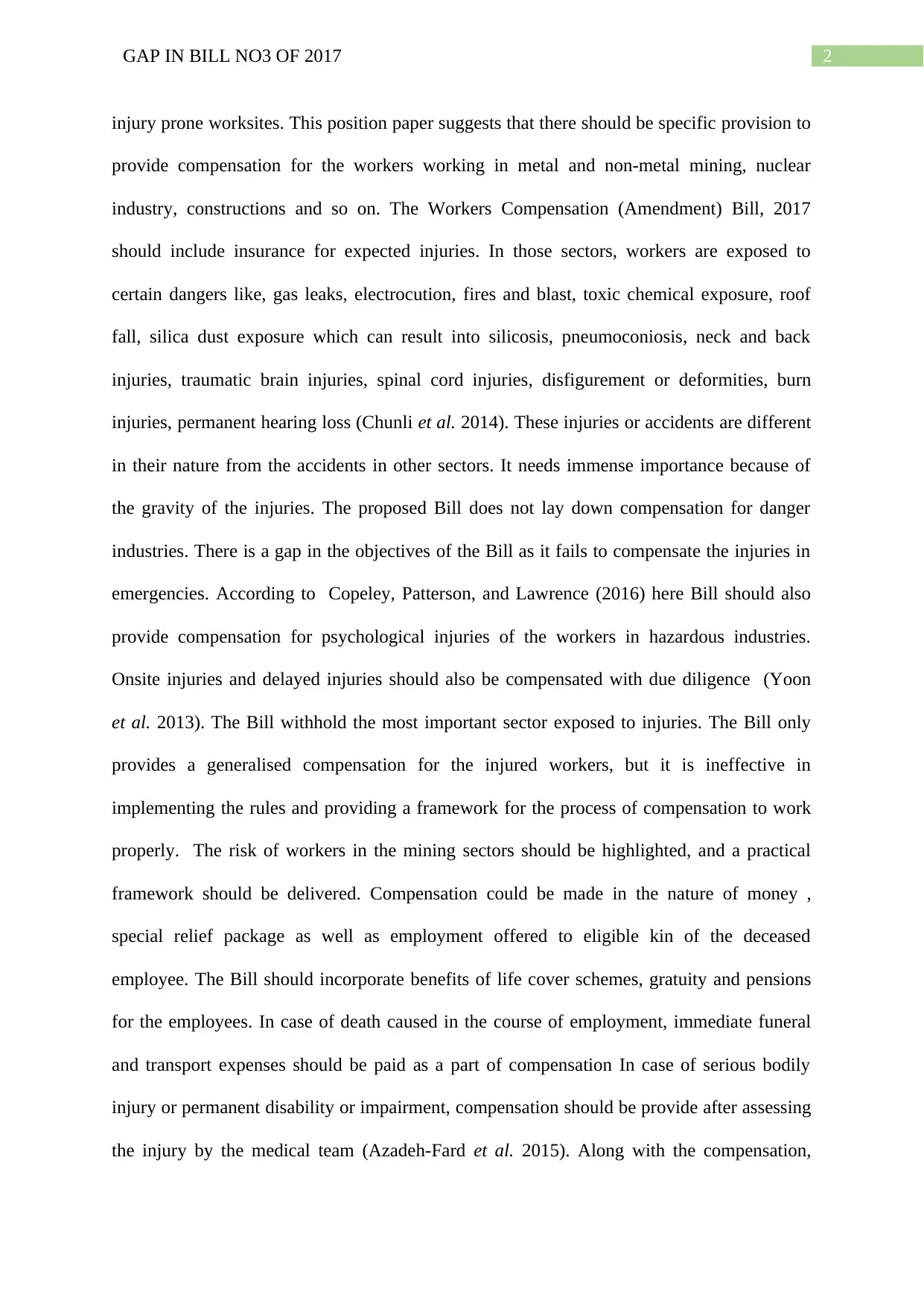
2GAP IN BILL NO3 OF 2017
injury prone worksites. This position paper suggests that there should be specific provision to
provide compensation for the workers working in metal and non-metal mining, nuclear
industry, constructions and so on. The Workers Compensation (Amendment) Bill, 2017
should include insurance for expected injuries. In those sectors, workers are exposed to
certain dangers like, gas leaks, electrocution, fires and blast, toxic chemical exposure, roof
fall, silica dust exposure which can result into silicosis, pneumoconiosis, neck and back
injuries, traumatic brain injuries, spinal cord injuries, disfigurement or deformities, burn
injuries, permanent hearing loss (Chunli et al. 2014). These injuries or accidents are different
in their nature from the accidents in other sectors. It needs immense importance because of
the gravity of the injuries. The proposed Bill does not lay down compensation for danger
industries. There is a gap in the objectives of the Bill as it fails to compensate the injuries in
emergencies. According to Copeley, Patterson, and Lawrence (2016) here Bill should also
provide compensation for psychological injuries of the workers in hazardous industries.
Onsite injuries and delayed injuries should also be compensated with due diligence (Yoon
et al. 2013). The Bill withhold the most important sector exposed to injuries. The Bill only
provides a generalised compensation for the injured workers, but it is ineffective in
implementing the rules and providing a framework for the process of compensation to work
properly. The risk of workers in the mining sectors should be highlighted, and a practical
framework should be delivered. Compensation could be made in the nature of money ,
special relief package as well as employment offered to eligible kin of the deceased
employee. The Bill should incorporate benefits of life cover schemes, gratuity and pensions
for the employees. In case of death caused in the course of employment, immediate funeral
and transport expenses should be paid as a part of compensation In case of serious bodily
injury or permanent disability or impairment, compensation should be provide after assessing
the injury by the medical team (Azadeh-Fard et al. 2015). Along with the compensation,
injury prone worksites. This position paper suggests that there should be specific provision to
provide compensation for the workers working in metal and non-metal mining, nuclear
industry, constructions and so on. The Workers Compensation (Amendment) Bill, 2017
should include insurance for expected injuries. In those sectors, workers are exposed to
certain dangers like, gas leaks, electrocution, fires and blast, toxic chemical exposure, roof
fall, silica dust exposure which can result into silicosis, pneumoconiosis, neck and back
injuries, traumatic brain injuries, spinal cord injuries, disfigurement or deformities, burn
injuries, permanent hearing loss (Chunli et al. 2014). These injuries or accidents are different
in their nature from the accidents in other sectors. It needs immense importance because of
the gravity of the injuries. The proposed Bill does not lay down compensation for danger
industries. There is a gap in the objectives of the Bill as it fails to compensate the injuries in
emergencies. According to Copeley, Patterson, and Lawrence (2016) here Bill should also
provide compensation for psychological injuries of the workers in hazardous industries.
Onsite injuries and delayed injuries should also be compensated with due diligence (Yoon
et al. 2013). The Bill withhold the most important sector exposed to injuries. The Bill only
provides a generalised compensation for the injured workers, but it is ineffective in
implementing the rules and providing a framework for the process of compensation to work
properly. The risk of workers in the mining sectors should be highlighted, and a practical
framework should be delivered. Compensation could be made in the nature of money ,
special relief package as well as employment offered to eligible kin of the deceased
employee. The Bill should incorporate benefits of life cover schemes, gratuity and pensions
for the employees. In case of death caused in the course of employment, immediate funeral
and transport expenses should be paid as a part of compensation In case of serious bodily
injury or permanent disability or impairment, compensation should be provide after assessing
the injury by the medical team (Azadeh-Fard et al. 2015). Along with the compensation,
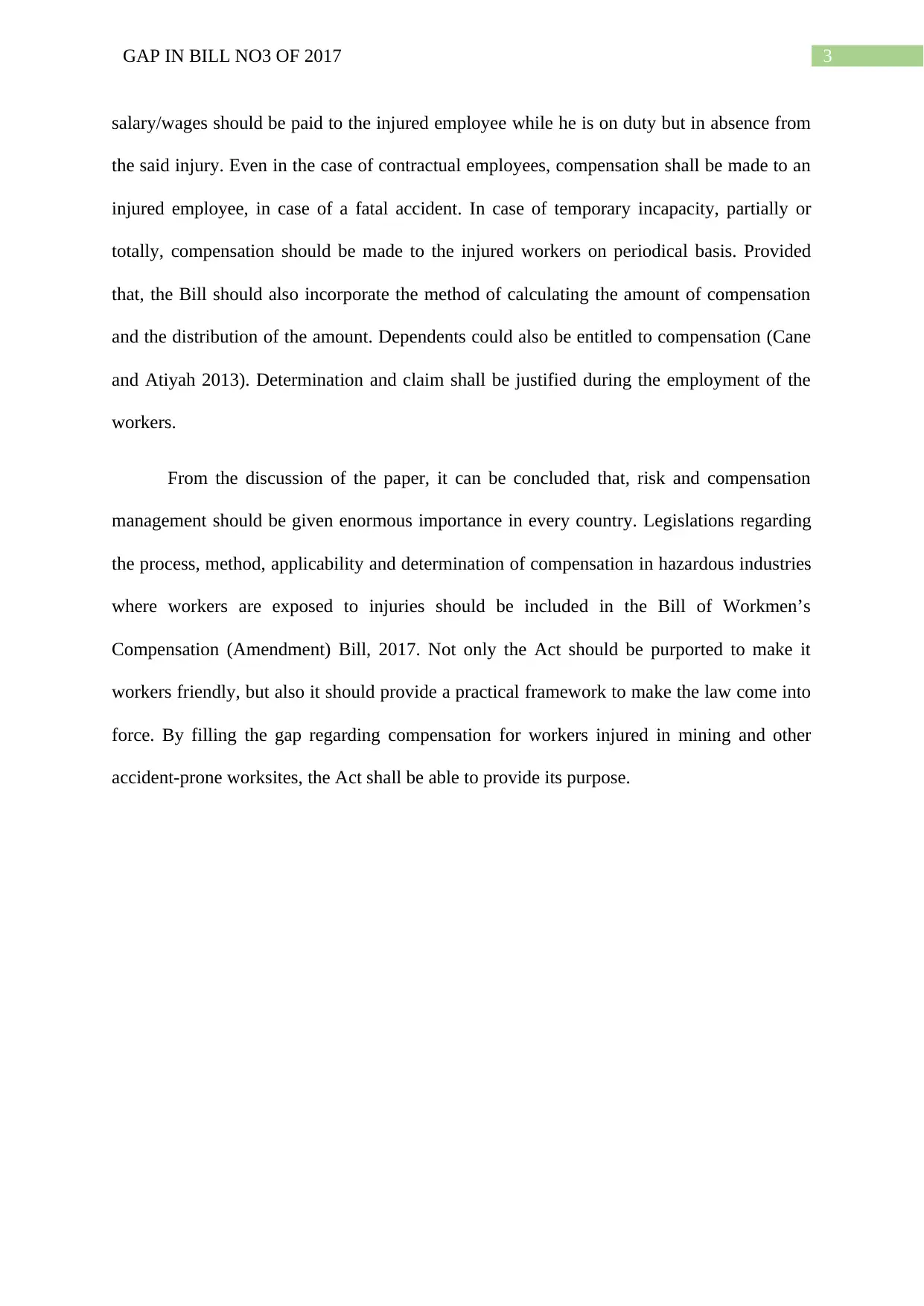
3GAP IN BILL NO3 OF 2017
salary/wages should be paid to the injured employee while he is on duty but in absence from
the said injury. Even in the case of contractual employees, compensation shall be made to an
injured employee, in case of a fatal accident. In case of temporary incapacity, partially or
totally, compensation should be made to the injured workers on periodical basis. Provided
that, the Bill should also incorporate the method of calculating the amount of compensation
and the distribution of the amount. Dependents could also be entitled to compensation (Cane
and Atiyah 2013). Determination and claim shall be justified during the employment of the
workers.
From the discussion of the paper, it can be concluded that, risk and compensation
management should be given enormous importance in every country. Legislations regarding
the process, method, applicability and determination of compensation in hazardous industries
where workers are exposed to injuries should be included in the Bill of Workmen’s
Compensation (Amendment) Bill, 2017. Not only the Act should be purported to make it
workers friendly, but also it should provide a practical framework to make the law come into
force. By filling the gap regarding compensation for workers injured in mining and other
accident-prone worksites, the Act shall be able to provide its purpose.
salary/wages should be paid to the injured employee while he is on duty but in absence from
the said injury. Even in the case of contractual employees, compensation shall be made to an
injured employee, in case of a fatal accident. In case of temporary incapacity, partially or
totally, compensation should be made to the injured workers on periodical basis. Provided
that, the Bill should also incorporate the method of calculating the amount of compensation
and the distribution of the amount. Dependents could also be entitled to compensation (Cane
and Atiyah 2013). Determination and claim shall be justified during the employment of the
workers.
From the discussion of the paper, it can be concluded that, risk and compensation
management should be given enormous importance in every country. Legislations regarding
the process, method, applicability and determination of compensation in hazardous industries
where workers are exposed to injuries should be included in the Bill of Workmen’s
Compensation (Amendment) Bill, 2017. Not only the Act should be purported to make it
workers friendly, but also it should provide a practical framework to make the law come into
force. By filling the gap regarding compensation for workers injured in mining and other
accident-prone worksites, the Act shall be able to provide its purpose.
Secure Best Marks with AI Grader
Need help grading? Try our AI Grader for instant feedback on your assignments.
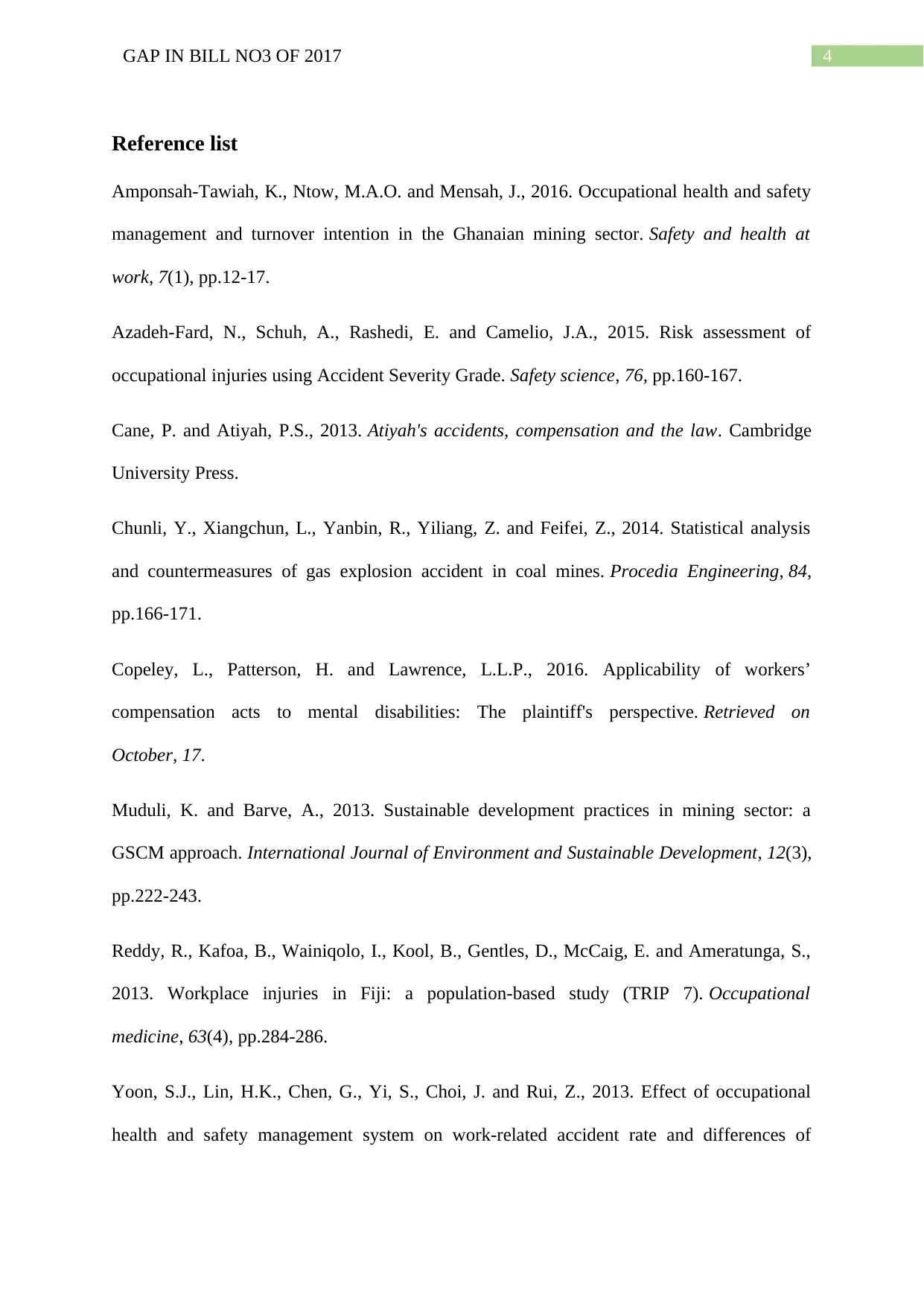
4GAP IN BILL NO3 OF 2017
Reference list
Amponsah-Tawiah, K., Ntow, M.A.O. and Mensah, J., 2016. Occupational health and safety
management and turnover intention in the Ghanaian mining sector. Safety and health at
work, 7(1), pp.12-17.
Azadeh-Fard, N., Schuh, A., Rashedi, E. and Camelio, J.A., 2015. Risk assessment of
occupational injuries using Accident Severity Grade. Safety science, 76, pp.160-167.
Cane, P. and Atiyah, P.S., 2013. Atiyah's accidents, compensation and the law. Cambridge
University Press.
Chunli, Y., Xiangchun, L., Yanbin, R., Yiliang, Z. and Feifei, Z., 2014. Statistical analysis
and countermeasures of gas explosion accident in coal mines. Procedia Engineering, 84,
pp.166-171.
Copeley, L., Patterson, H. and Lawrence, L.L.P., 2016. Applicability of workers’
compensation acts to mental disabilities: The plaintiff's perspective. Retrieved on
October, 17.
Muduli, K. and Barve, A., 2013. Sustainable development practices in mining sector: a
GSCM approach. International Journal of Environment and Sustainable Development, 12(3),
pp.222-243.
Reddy, R., Kafoa, B., Wainiqolo, I., Kool, B., Gentles, D., McCaig, E. and Ameratunga, S.,
2013. Workplace injuries in Fiji: a population-based study (TRIP 7). Occupational
medicine, 63(4), pp.284-286.
Yoon, S.J., Lin, H.K., Chen, G., Yi, S., Choi, J. and Rui, Z., 2013. Effect of occupational
health and safety management system on work-related accident rate and differences of
Reference list
Amponsah-Tawiah, K., Ntow, M.A.O. and Mensah, J., 2016. Occupational health and safety
management and turnover intention in the Ghanaian mining sector. Safety and health at
work, 7(1), pp.12-17.
Azadeh-Fard, N., Schuh, A., Rashedi, E. and Camelio, J.A., 2015. Risk assessment of
occupational injuries using Accident Severity Grade. Safety science, 76, pp.160-167.
Cane, P. and Atiyah, P.S., 2013. Atiyah's accidents, compensation and the law. Cambridge
University Press.
Chunli, Y., Xiangchun, L., Yanbin, R., Yiliang, Z. and Feifei, Z., 2014. Statistical analysis
and countermeasures of gas explosion accident in coal mines. Procedia Engineering, 84,
pp.166-171.
Copeley, L., Patterson, H. and Lawrence, L.L.P., 2016. Applicability of workers’
compensation acts to mental disabilities: The plaintiff's perspective. Retrieved on
October, 17.
Muduli, K. and Barve, A., 2013. Sustainable development practices in mining sector: a
GSCM approach. International Journal of Environment and Sustainable Development, 12(3),
pp.222-243.
Reddy, R., Kafoa, B., Wainiqolo, I., Kool, B., Gentles, D., McCaig, E. and Ameratunga, S.,
2013. Workplace injuries in Fiji: a population-based study (TRIP 7). Occupational
medicine, 63(4), pp.284-286.
Yoon, S.J., Lin, H.K., Chen, G., Yi, S., Choi, J. and Rui, Z., 2013. Effect of occupational
health and safety management system on work-related accident rate and differences of
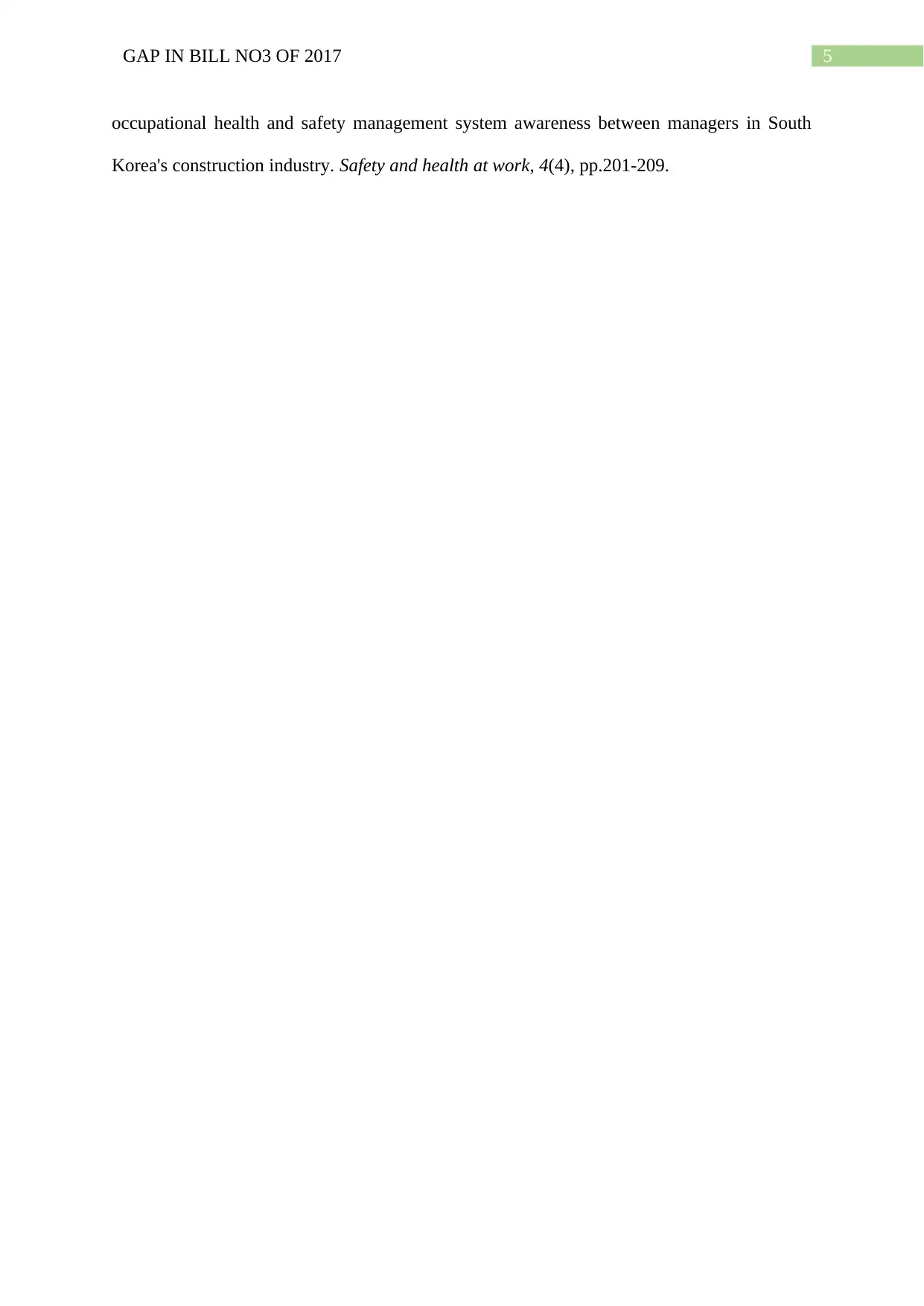
5GAP IN BILL NO3 OF 2017
occupational health and safety management system awareness between managers in South
Korea's construction industry. Safety and health at work, 4(4), pp.201-209.
occupational health and safety management system awareness between managers in South
Korea's construction industry. Safety and health at work, 4(4), pp.201-209.
1 out of 6
Your All-in-One AI-Powered Toolkit for Academic Success.
+13062052269
info@desklib.com
Available 24*7 on WhatsApp / Email
![[object Object]](/_next/static/media/star-bottom.7253800d.svg)
Unlock your academic potential
© 2024 | Zucol Services PVT LTD | All rights reserved.
